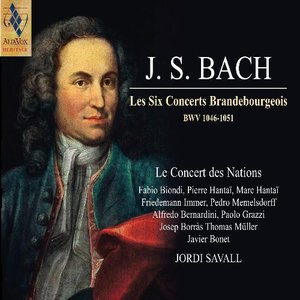
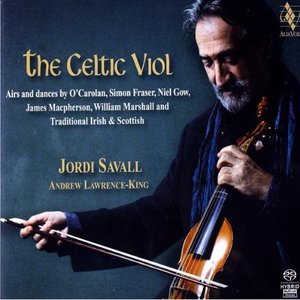
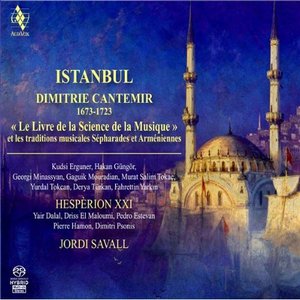
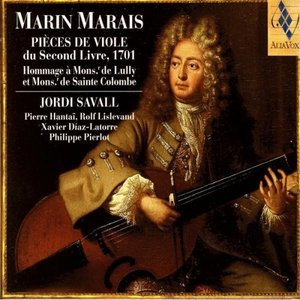
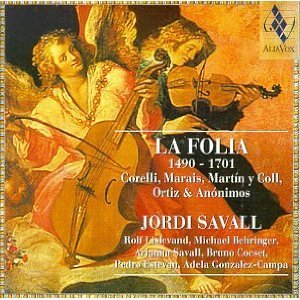
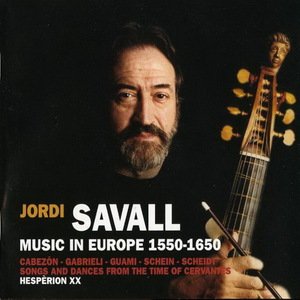
Jordi Savall is among the leading instrumentalists and conductors of the European early music scene, specializing in Renaissance and Medieval music. He began studying music when he was six, learning cello and pursuing that instrument at the Barcelona Conservatory. He took an interest in early music, and began learning the viola da gamba. Savall also gained proficiency in the various members of the viola family. He studied the gamba and early music research and practice with Wieland Kuijken in Brussels and August Wenziger at the Schola Cantorum Basiliensis in Basel, obtaining a diploma as soloist and professor in 1970. In 1973 he succeeded to Wenziger's position.
In 1968 Savall married the soprano Montserrat Figueras, who shared his interest in early music. With Figueras and other musicians interested in early Spanish music, he founded in 1974 the ensemble Hespèrion XX. The ensemble took its name from an ancient name for the western European region from Italy to Iberia; Hespèrion was also a name for Venus as the Evening Star (in which aspect it appears only in the western skies). At the turn of the 21st century, the group changed its name to Hespèrion XXI.
Savall and Hespèrion XX quickly became well known in early music circles. They created a unique sound through the use of viols and other Medieval instruments such as the psaltery, wooden flutes, Moroccan drums, and the Afghan rebec (a double reed ancestor of the oboe). All these instrument are known to have been used by Medieval musicians, particularly in the Mediterranean region.
Savall became internationally known through his playing on the soundtrack of Alain Corneau's film Tous les Matins du Monde (All the Mornings of the World), concerning the French viol players of the Baroque era. Savall has extended his area of musical interest into the Baroque, leading performances of Orfeo by Monteverdi and Il burbero de Buion Cuore by Martin y Soler, and in the late 1990s conducted Beethoven's "Eroica" Symphony with Les Concerts des Nations (a group he founded in 1989 for Baroque music), winning praise for his well-researched and groundbreaking interpretation. He also founded Le Capella Reial de Catalunya in 1987, an ensemble of instrumentalists and vocal soloists.
Savall has recorded well over 100 albums. Until 1996, most of Savall's recordings appeared on the Astrée Auvidis label, but this legacy became part of Naïve after Astrée was sold to them in 2001. In 1996, Savall introduced his own AliaVox label with a disc of Juan Cabanilles that has served as the platform for his recordings ever since. Savall has also taken advantage of his celebrity through traveling as a touring artist throughout the world with all three of his actively performing groups. His honors include an honorary doctorate from the University of Barcelona (2000), multiple Grammy nominations, and in 2008 UNESCO recognized Savall and Figueras as "Artists for Peace."
Biography by Rovi Staff - Source: allmusic
Born on August 1, 1941, in Igualada, near Barcelona, Spain; married Montserrat Figueras (a musician), 1968. Education: Barcelona Conservatory, diploma; Schola Cantorum Basiliensis, diploma, 1970. Addresses: Record company---Naive Classique, 148 rue du Faubourg Possinière, 75010 Paris, France.
The works performed by Catalan gambist and conductor Jordi Savall span several centuries---from the music of Alfonso el Sabio, king of Castile and Léon, to the works of J. S. Bach---bringing to life the splendor and passion of bygone eras. A performance by Savall is more than a musical experience: the extraordinary power and beauty of his playing magically removes the listener from the flux of time, creating a space in which such obstacles to enjoyment as historical distance, stylistic peculiarities, and idiomatic enigmas simply disappear. For example, historical periods, including the Baroque, have often been described as "distant." Indeed, the physical and mental universe of seventeenth-century France may seem distant to a person living in the twenty-first century. But that distance vanishes when Savall plays the music of the great French master of the bass viol, Marin Marais.
First of all, Savall's main instrument is the viola da gamba, or bass viol (he also plays the smaller viols), not as a quaint relic that needs some special justification or antiquarian explanation. True, in the late 1700s, the viola da gamba---which is not a different kind of cello, but a member of the viol family, a distinct group of instruments of varying sizes---was supplanted by the cello, as the latter instrument, with its potential for virtuosity, satisfied the requirements of changing musical styles. However, to Savall, his instrument is irreplaceable. In fact, according to Savall, the viola da gamba has a particular sonic richness that the more "modern" cello lacks. As Savall explained to Chris Pasles of the Los Angeles Times, the "viola da gamba is totally different from a cello. It's closer to the lute---a lute with a bow, in fact. With six strings, frets like a guitar, a softer sound, it's more rich in different colors." Instead of merely reproducing a particular musical composition, Savall captures and expresses the timeless humanity of the music, illuminating the particular composition as a universally comprehensible document of the human experience. A case in point is Savall's mesmerizing performance of Marais's musical description, found in Book V of his Pièces de viole, of his gallstone operation. Written under the influence of François Couperin's character pieces, this extraordinary composition, especially in Savall's version, remains one of the most suggestively dramatic works of Baroque music.
Born in 1941, near the Catalan city of Barcelona, Savall began his musical education at the age of six. After graduation from the Barcelona Conservatory, where he studied the cello, Savall went to Basel, Switzerland, where he studied the viola da gamba with August Wenzinger at the Schola Cantorum Basiliensis, receiving a diploma in 1970. His other teachers included Wieland Kuijken, in Brussels. In 1973 Savall took over Wenzinger's post at the Schola Cantorum. By the early 1970s, Savall was already considered one the greatest viola da gamba players. In addition, he worked hard to enrich his instrument's repertoire, rescuing many works from oblivion and performing and recording numerous forgotten compositions. Savall thus exemplified, as he still does, the learned performer, who constantly studies the vast field of old music, bringing many neglected compositions to light. Among these lesser-known compositions are works by Marais, whose rich and fascinating oeuvre includes more than 500 pieces for viola da gamba and keyboard accompaniment, assembled in five books of his Pièces de viole.
In 1974 Savall and his wife, soprano Montserrat Figueras, founded Hespèrion XX---later, in the twenty-first century, known as Hespèrion XXI---an international ensemble that has gained great acclaim for its extraordinary performances of music from the Middle Ages to the Baroque. In 1987, returning to his native city after his extensive sojourn in foreign lands, Savall formed the Capella Reial de Catalunya, a vocal group that, under his direction, has performed and recorded music by Tomáa Luis de Victoria, Francisco Guerrero, and Claudio Monteverdi.
In 1989, further expanding his repertoire and musical activities, Savall founded the Concert des Nations, an ensemble consisting of younger musicians from Spain and Latin America. Under Savall's direction, this orchestra, which plays on period instruments, has recorded a variety of works from the Baroque and Classical periods.
Savall's career received a tremendous boost when film director Alain Corneau asked him to play on the soundtrack for Tous les matins du monde, his 1992 film about Marais and his teacher, Sainte-Colombe. Based on Pascal Quignard's admirable 1991 novel--available in English as All the World's Mornings--which imagines the life of the mysterious Sieur de Sainte-Colombe, the film is a spell-binding portrait of seventeenth-century France with the music, performed by Savall, providing a foundation for the narrative. Savall himself indirectly inspired Quignard's novel: it was a 1976 recording by Savall that introduced the writer to Sainte-Colombe's music. The music that Savall performs on the soundtrack is mostly by Marais and Sainte-Colombe, though it also includes a segment of François Couperin's deeply spiritual Leçons des ténèbres. Savall is inspired in his performance of the heartrending Tombeau les regrets, which, in Quignard's imagination, Sainte-Colombe played to conjure up the spirit of his deceased wife. In Savall's hands, this music, which appears as a leitmotif throughout the film, graces the rich tapestry of the film as a mysterious aura.
In 1988 the French Ministry of Culture awarded Savall the title of Officier de l'Ordre des Arts et Lettres. His recordings, numbering more than one hundred, have received many awards, including the Double Disc of Gold and the Diapason d'Or. In 1997 Savall's recording company, Astrée, founded a separate label, Fontalis, for his recordings. The following year, Savall started his own label, Alia Vox, which later reissued many of his earlier recordings at an affordable price. Savall's remarkable career is more than a personal triumph: thanks to his superb musicianship, the viola de gamba has emerged from the shadows of the past, becoming the instrument of choice for many younger performers. For such performers, the rich repertoire of the Renaissance and Baroque offers not only infinite artistic challenges and possibilities but the opportunity to abolish the somewhat artificial barrier separating "early" music from the rest of the musical tradition.
Biography by Zoran Minderovic
The works performed by Catalan gambist and conductor Jordi Savall span several centuries---from the music of Alfonso el Sabio, king of Castile and Léon, to the works of J. S. Bach---bringing to life the splendor and passion of bygone eras. A performance by Savall is more than a musical experience: the extraordinary power and beauty of his playing magically removes the listener from the flux of time, creating a space in which such obstacles to enjoyment as historical distance, stylistic peculiarities, and idiomatic enigmas simply disappear. For example, historical periods, including the Baroque, have often been described as "distant." Indeed, the physical and mental universe of seventeenth-century France may seem distant to a person living in the twenty-first century. But that distance vanishes when Savall plays the music of the great French master of the bass viol, Marin Marais.
First of all, Savall's main instrument is the viola da gamba, or bass viol (he also plays the smaller viols), not as a quaint relic that needs some special justification or antiquarian explanation. True, in the late 1700s, the viola da gamba---which is not a different kind of cello, but a member of the viol family, a distinct group of instruments of varying sizes---was supplanted by the cello, as the latter instrument, with its potential for virtuosity, satisfied the requirements of changing musical styles. However, to Savall, his instrument is irreplaceable. In fact, according to Savall, the viola da gamba has a particular sonic richness that the more "modern" cello lacks. As Savall explained to Chris Pasles of the Los Angeles Times, the "viola da gamba is totally different from a cello. It's closer to the lute---a lute with a bow, in fact. With six strings, frets like a guitar, a softer sound, it's more rich in different colors." Instead of merely reproducing a particular musical composition, Savall captures and expresses the timeless humanity of the music, illuminating the particular composition as a universally comprehensible document of the human experience. A case in point is Savall's mesmerizing performance of Marais's musical description, found in Book V of his Pièces de viole, of his gallstone operation. Written under the influence of François Couperin's character pieces, this extraordinary composition, especially in Savall's version, remains one of the most suggestively dramatic works of Baroque music.
Born in 1941, near the Catalan city of Barcelona, Savall began his musical education at the age of six. After graduation from the Barcelona Conservatory, where he studied the cello, Savall went to Basel, Switzerland, where he studied the viola da gamba with August Wenzinger at the Schola Cantorum Basiliensis, receiving a diploma in 1970. His other teachers included Wieland Kuijken, in Brussels. In 1973 Savall took over Wenzinger's post at the Schola Cantorum. By the early 1970s, Savall was already considered one the greatest viola da gamba players. In addition, he worked hard to enrich his instrument's repertoire, rescuing many works from oblivion and performing and recording numerous forgotten compositions. Savall thus exemplified, as he still does, the learned performer, who constantly studies the vast field of old music, bringing many neglected compositions to light. Among these lesser-known compositions are works by Marais, whose rich and fascinating oeuvre includes more than 500 pieces for viola da gamba and keyboard accompaniment, assembled in five books of his Pièces de viole.
In 1974 Savall and his wife, soprano Montserrat Figueras, founded Hespèrion XX---later, in the twenty-first century, known as Hespèrion XXI---an international ensemble that has gained great acclaim for its extraordinary performances of music from the Middle Ages to the Baroque. In 1987, returning to his native city after his extensive sojourn in foreign lands, Savall formed the Capella Reial de Catalunya, a vocal group that, under his direction, has performed and recorded music by Tomáa Luis de Victoria, Francisco Guerrero, and Claudio Monteverdi.
In 1989, further expanding his repertoire and musical activities, Savall founded the Concert des Nations, an ensemble consisting of younger musicians from Spain and Latin America. Under Savall's direction, this orchestra, which plays on period instruments, has recorded a variety of works from the Baroque and Classical periods.
Savall's career received a tremendous boost when film director Alain Corneau asked him to play on the soundtrack for Tous les matins du monde, his 1992 film about Marais and his teacher, Sainte-Colombe. Based on Pascal Quignard's admirable 1991 novel--available in English as All the World's Mornings--which imagines the life of the mysterious Sieur de Sainte-Colombe, the film is a spell-binding portrait of seventeenth-century France with the music, performed by Savall, providing a foundation for the narrative. Savall himself indirectly inspired Quignard's novel: it was a 1976 recording by Savall that introduced the writer to Sainte-Colombe's music. The music that Savall performs on the soundtrack is mostly by Marais and Sainte-Colombe, though it also includes a segment of François Couperin's deeply spiritual Leçons des ténèbres. Savall is inspired in his performance of the heartrending Tombeau les regrets, which, in Quignard's imagination, Sainte-Colombe played to conjure up the spirit of his deceased wife. In Savall's hands, this music, which appears as a leitmotif throughout the film, graces the rich tapestry of the film as a mysterious aura.
In 1988 the French Ministry of Culture awarded Savall the title of Officier de l'Ordre des Arts et Lettres. His recordings, numbering more than one hundred, have received many awards, including the Double Disc of Gold and the Diapason d'Or. In 1997 Savall's recording company, Astrée, founded a separate label, Fontalis, for his recordings. The following year, Savall started his own label, Alia Vox, which later reissued many of his earlier recordings at an affordable price. Savall's remarkable career is more than a personal triumph: thanks to his superb musicianship, the viola de gamba has emerged from the shadows of the past, becoming the instrument of choice for many younger performers. For such performers, the rich repertoire of the Renaissance and Baroque offers not only infinite artistic challenges and possibilities but the opportunity to abolish the somewhat artificial barrier separating "early" music from the rest of the musical tradition.
Biography by Zoran Minderovic
Source: Musician Guide
Watch and listen the videos: Lachrimae Caravaggio,
Folies d'Espagne, Le Royaume Oubliê (CD 1, 2 e 3),
Popular videos (200 videos), Popular videos Diego
Ortiz and Jordi Savall (200 videos), Marin Marais:
Piece de Viole and Tombeau from II Livre, Isabel I
Reina de Castilla,El Cant de La Sibilla, Mare Nostrum,
Rameau: L'Orchestre de Louis XV, Dimitrie Cantemir: Istanbul, El Libre Vermell de Montserrat, Bach:The Art of Fugue BMV 1080, Ostinato Works of Various Composers, François Couperin:Les Concert Royaux, Alfonso X el Sabio: Cantigas Santa Maria, Tous les Matins du Monde, Esprit d'Armenie, Mare Adriaticum,
Bach: L'Offrande Musicale BMV 1079, Les Voix de la
Viole, Dimitrie Cantemir: Le Livre de la science de
la musique, Estampies Royales, Jerusalén: La Ciudad
de Las Dos Paces, Uskudara, Bach: Mass in B Minor BMV 232,Bach and Handel: Orchestral Suites,Ombres et Lumières du Siécle d'Or, La Cancion Bailada and La
Danza Cantada, Bach: 6 Brandenburg Concertos BMV
1046-1051, Bach: Orchestral Suites BMV 1066-1069,
Hispania and Japan dialogues, Charpentier: Messe Et
Motets Pour La Vierge, Vivaldi: Violin Concertos, Jean
Baptiste Lully: L'Orchestre du Roi Soleil, Diego Ortiz:
Recercadas del Trattado de Glosas, Greensleeves,
Marin Marais: Pieces for Viola da Gamba 5th book,
Les Voix Humaines, La Dinastia Borgia, Mozart:
Folies d'Espagne, Le Royaume Oubliê (CD 1, 2 e 3),
Popular videos (200 videos), Popular videos Diego
Ortiz and Jordi Savall (200 videos), Marin Marais:
Piece de Viole and Tombeau from II Livre, Isabel I
Reina de Castilla,El Cant de La Sibilla, Mare Nostrum,
Rameau: L'Orchestre de Louis XV, Dimitrie Cantemir: Istanbul, El Libre Vermell de Montserrat, Bach:The Art of Fugue BMV 1080, Ostinato Works of Various Composers, François Couperin:Les Concert Royaux, Alfonso X el Sabio: Cantigas Santa Maria, Tous les Matins du Monde, Esprit d'Armenie, Mare Adriaticum,
Bach: L'Offrande Musicale BMV 1079, Les Voix de la
Viole, Dimitrie Cantemir: Le Livre de la science de
la musique, Estampies Royales, Jerusalén: La Ciudad
de Las Dos Paces, Uskudara, Bach: Mass in B Minor BMV 232,Bach and Handel: Orchestral Suites,Ombres et Lumières du Siécle d'Or, La Cancion Bailada and La
Danza Cantada, Bach: 6 Brandenburg Concertos BMV
1046-1051, Bach: Orchestral Suites BMV 1066-1069,
Hispania and Japan dialogues, Charpentier: Messe Et
Motets Pour La Vierge, Vivaldi: Violin Concertos, Jean
Baptiste Lully: L'Orchestre du Roi Soleil, Diego Ortiz:
Recercadas del Trattado de Glosas, Greensleeves,
Marin Marais: Pieces for Viola da Gamba 5th book,
Les Voix Humaines, La Dinastia Borgia, Mozart:
Nenhum comentário:
Postar um comentário